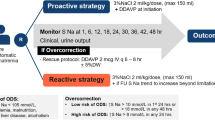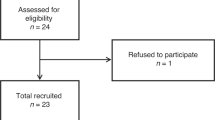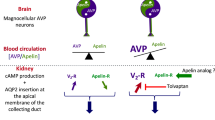Abstract
Vasopressin-2 receptor antagonists, collectively known as the 'vaptans', provide a new approach to the treatment of hyponatremia; therefore, an updated Review of the pathophysiology of hyponatremia is particularly timely. After briefly defining hyponatremia and introducing its clinical aspects and complications, we present an approach to the diagnosis and evaluation of hyponatremia that is based primarily on the often-underused concept of free water clearance and, more specifically, the electrolyte-free water clearance. Then we review the use of vasopressin receptor antagonists in the management of hyponatremia from the standpoint of their pharmacology, their mechanism of action, and available efficacy data from clinical trials.
Key Points
-
Pathogenesis of hyponatremia involves an imbalance between water intake and water output
-
Hyponatremia is categorized according to severity, chronicity and patient volume status; there are therapeutic ramifications associated with each category
-
Calculating the electrolyte-free water clearance—especially the urine:plasma electrolyte ratio—can help to guide prescription of water restriction and response to other therapies
-
Vasopressin receptor antagonists (aquaretics) seem to be safe and effective for treatment of euvolemic and hypervolemic hyponatremia
This is a preview of subscription content, access via your institution
Access options
Subscribe to this journal
Receive 12 print issues and online access
$209.00 per year
only $17.42 per issue
Buy this article
- Purchase on Springer Link
- Instant access to full article PDF
Prices may be subject to local taxes which are calculated during checkout




Similar content being viewed by others
References
Robertson GL (2001) Antidiuretic hormone: normal and disordered function. Endocrinol Metab Clin North Am 30: 671–694
Costello-Boerrigter LC et al. (2003) Revisiting salt and water retention: new diuretics, aquaretics, and natriuretics. Med Clin North Am 87: 475–491
Hayashi M et al. (1994) Expression and distribution of aquaporin of collecting duct are regulated by vasopressin V2 receptor in rat kidney. J Clin Invest 94: 1778–1783
Wong LL and Verbalis JG (2002) Systemic diseases associated with disorders of water homeostasis. Endocrinol Metab Clin North Am 31: 121–140
Decaux G et al. (2000) Hyponatremia in the intensive care: from diagnosis to treatment. Acta Clin Belg 55: 68–78
Brown OA (2004) Understanding postoperative hyponatremia. Urol Nurs 24: 197–201
Casulari LA et al. (2004) Differential diagnosis and treatment of hyponatremia following pituitary surgery. J Neurosurg Sci 48: 11–18
Coenraad MJ et al. (2001) Hyponatremia in intracranial disorders. Neth J Med 58: 123–127
Janicic N and Verbalis JG (2003) Evaluation and management of hypo-osmolality in hospitalized patients. Endocrinol Metab Clin North Am 32: 459–481
Soupart A and Decaux G (1996) Therapeutic recommendations for management of severe hyponatremia: current concepts on pathogenesis and prevention of neurologic complications. Clin Nephrol 46: 149–169
Gross P et al. (2001) Treatment of severe hyponatremia: conventional and novel aspects. J Am Soc Nephrol 12 (Suppl): S10–S14
Sterns RH (1987) Severe symptomatic hyponatremia: treatment and outcome: a study of 64 cases. Ann Intern Med 107: 656–664
Fried LF and Palevsky PM (1997) Hyponatremia and hypernatremia. Med Clin North Am 81: 585–609
Boscoe A et al. (2006) Cost of illness of hyponatremia in the United States. Cost Eff Resour Alloc 4: 10–20
Greenberg A and Verbalis JG (2006) Vasopressin receptor antagonists. Kidney Int 69: 2124–2130
Baylis PH (2003) The syndrome of inappropriate antidiuretic hormone secretion. Int J Biochem Cell Biol 35: 1495–1499
Palmer BF (2003) Hyponatremia in patients with central nervous system disease: SIADH versus CSW. Trends Endocrinol Metab 14: 182–187
Mulloy AL and Caruana RJ (1995) Hyponatremic emergencies. Med Clin North Am 79: 155–168
Goh KP (2004) Management of hyponatremia. Am Fam Physician 69: 2387–2394
Adrogue HJ and Madias NE (2000) Hyponatremia. N Engl J Med 342: 1581–1589
Moritz ML and Ayus JC (2003) The pathophysiology and treatment of hyponatraemic encephalopathy: an update. Nephrol Dial Transplant 18: 2486–2491
Fraser CL and Arieff AI (1997) Epidemiology, pathophysiology, and management of hyponatremic encephalopathy. Am J Med 102: 67–77
Sterns RH et al. (1994) Neurologic sequelae after treatment of severe hyponatremia: a multicenter perspective. J Am Soc Nephrol 4: 1522–1530
Ayus JC et al. (2006) Hyponatremia with hypoxia: effects on brain adaptation, perfusion, and histology in rodents. Kidney Int 69: 1319–1325
Ghali JK et al. (2006) Efficacy and safety of oral conivaptan: a V1A/V2 vasopressin-receptor antagonist, assessed in a randomized, placebo-controlled trial in patients with euvolemic or hypervolemic hyponatremia. J Clin Endocrinol Metab 91: 2145–2152
Rabinstein AA and Wijdicks EF (2003) Hyponatremia in critically ill neurological patients. Neurologist 9: 290–300
Harrigan MR (2001) Cerebral salt wasting syndrome. Crit Care Clin 17: 125–138
Shoker AS (1994) Application of the clearance concept to hyponatremic and hypernatremic disorders: a phenomenological analysis. Clin Chem 40: 1220–1227
Ayus JC et al. (1987) Treatment of symptomatic hyponatremia and its relation to brain damage. N Engl J Med 317: 1190–1195
Rose BD (1986) New approach to disturbances in the plasma sodium concentration. Am J Med 81: 1033–1040
Edelman IS et al. (1958) Interrelations between serum sodium concentration, serum osmolarity and total exchangeable sodium, total exchangeable potassium and total body water. J Clin Invest 37: 1236–1256
Furst H et al. (2000) The urine/plasma electrolyte ratio: a predictive guide to water restriction. Am J Med Sci 319: 240–244
Schrier RW (1985) Treatment of hyponatremia. N Engl J Med 312: 1121–1123
Decaux G and Soupart A (2003) Treatment of symptomatic hyponatremia. Am J Med Sci 326: 25–30
Decaux G (2001) Long-term treatment of patients with inappropriate secretion of antidiuretic hormone by the vasopressin receptor antagonist conivaptan, urea, or furosemide. Am J Med 110: 582–584
Decaux G et al. (1980) Treatment of the syndrome of inappropriate secretion of antidiuretic hormone by urea. Am J Med 69: 99–106
Decaux G et al. (1981) Treatment of the syndrome of inappropriate secretion of antidiuretic hormone with furosemide. N Engl J Med 304: 329–330
Forrest JN et al. (1978) Superiority of demeclocycline over lithium in the treatment of chronic syndrome of inappropriate secretion of antidiuretic hormone. N Engl J Med 298: 173–177
Han DS and Cho BS (2002) Therapeutic approach to hyponatremia. Nephron 92: 9–13
Kleinschmidt-Demasters BK et al. (2006) Central and extrapontine myelinolysis: then...and now. J Neuropathol Exp Neurol 65: 1–11
Laureno R and Karp BI (1997) Myelinolysis after correction of hyponatremia. Ann Intern Med 126: 57–62
Birnbaumer M (2000) Vasopressin receptors. Trends Endocrinol Metab 11: 406–410
Nielsen S et al. (1995) Vasopressin increases water permeability of kidney collecting duct by inducing translocation of aquaporin-CD water channels to plasma membrane. Proc Natl Acad Sci USA 92: 1013–1017
DiGiovanni SR et al. (1994) Regulation of collecting duct water channel expression by vasopressin in Brattleboro rat. Proc Natl Acad Sci USA 91: 8984–8988
Rai T (1997) Urinary excretion of aquaporin-2 water channel protein in human and rat. J Am Soc Nephrol 8: 1357–1362
Saito T et al. (1997) Urinary excretion of aquaporin-2 in the diagnosis of central diabetes insipidus. J Clin Endocrinol Metab 82: 1823–1827
Martin P-Y et al. (1999) Selective V2-receptor vasopressin antagonism decreases urinary aquaporin-2 excretion in patients with chronic heart failure. J Am Soc Nephrol 10: 2165–2170
Wong LL and Verbalis JG (2001) Vasopressin V2 receptor antagonists. Cardiovasc Res 51: 391–402
Verbalis JG (2002) Vasopressin V2 receptor antagonists. J Mol Endocrinol 29: 1–9
Schrier RW et al. (2001) Water-losing and water-retaining states: role of water channels and vasopressin receptor antagonists. Heart Dis 3: 210–214
Goldsmith SR and Gheorghiade M (2005) Vasopressin antagonism in heart failure. J Am Coll Cardiol 46: 1785–1791
Gheorghiade M (2006) The clinical effects of vasopressin receptor antagonists in heart failure. Cleve Clin J Med 73 (Suppl 2): S24–S29
Saito T et al. (1997) Acute aquaresis by the nonpeptide arginine vasopressin (AVP) antagonist OPC-31260 improves hyponatremia in patients with syndrome of inappropriate secretion of antidiuretic hormone (SIADH). J Clin Endocrinol Metab 82: 1054–1057
Gross P (2004) Conivaptan, a novel V1a/V2 antagonist, increases serum sodium and effective water clearance in hyponatremia. J Am Soc Nephrol 15: 353A
Udelson JE et al. (2001) Acute hemodynamic effects of conivaptan, a dual V(1A) and V(2) vasopressin receptor antagonist, in patients with advanced heart failure. Circulation 104: 2417–2423
Verbalis JG et al. (2004) Novel vasopressin V1a and V2 antagonist conivaptan increases serum sodium concentration and effective water clearance in hyponatremia. J Am Soc Nephrol 15: 356A
Lemmens-Gruber R and Kamyar M (2006) Vasopressin antagonists. Cell Mol Life Sci 63: 1766–1779
Wong F et al. (2003) A vasopressin receptor antagonist (VPA-985) improves serum sodium concentration in patients with hyponatremia: a multicenter, randomized, placebo-controlled trial. Hepatology 37: 182–191
Gerbes AL et al. (2003) Therapy of hyponatremia in cirrhosis with a vasopressin receptor antagonist: a randomized double blind multicenter trial. Gastroenterology 124: 933–939
Abraham WT et al. (2006) Aquaretic effect of lixivaptan, an oral, non-peptide, selective V2 receptor vasopressin antagonist, in New York Heart Association functional class II and III chronic heart failure patients. J Am Coll Cardiol 47: 1615–1621
Decaux G (2001) Difference in solute excretion during correction of hyponatremic patients with cirrhosis or syndrome of inappropriate secretion of antidiuretic hormone by oral vasopressin V2 receptor antagonist VPS 985. J Lab Clin Med 138: 18–21
Gheorghiade M et al. (2003) Vasopressin V2-receptor blockade with tolvaptan in patients with chronic heart failure: results from a double blind, randomized trial. Circulation 107: 2690–2696
Gheorghiade M et al. (2004) Effects of tolvaptan, a vasopressin antagonist, in patients hospitalized with worsening heart failure: a randomized controlled trial (ACTIV in CHF). JAMA 291: 1963–1971
Gheorghiade M et al. (2006) Vasopressin V2 receptor blockade with tolvaptan versus fluid restriction in the treatment of hyponatremia. Am J Cardiol 97: 1064–1067
Costello-Boerrigter LC et al. (2006) Vasopressin-2 receptor antagonism augments water excretion without changes in renal hemodynamics or sodium and potassium excetion in human heart failure. Am J Physiol Renal Physiol 290: F273–F278
Gheorghiade M et al. (2005) Rationale and design of the multicenter, randomized, double blind, placebo-controlled study to evaluate the efficacy of vasopressin antagonism in heart failure: outcome study with Tolvaptan (EVEREST). J Card Fail 11: 260–269
Schrier RW et al. (2006) Tolvaptan, a selective oral vasopressin V2-receptor antagonist, for hyponatremia. N Engl J Med 355: 2099–2112
Gunnet J et al. (2006) Characterization of RWJ-351647, a novel nonpeptide vasopressin V2 receptor antagonist. Clin Exp Pharmacol Physiol 33: 320–326
Acknowledgements
We acknowledge the classic studies by Schrier and co-workers, and the recent work on vaptans. It is impossible to be inclusive, but we would like to collectively recognize the countless investigators who have advanced our understanding of hyponatremia and its treatment. S Chen and N Jalandhara declared no competing interests.
Author information
Authors and Affiliations
Corresponding author
Ethics declarations
Competing interests
D Batlle has received consultation fees from Astellas. He will receive a grant from Otsuka as part of a multicenter study on PKD using tolvaptan, and possibly from Astellas for a study on hyponatremia using conivaptan. S Chen and N Jalandhara declared no competing interests.
Rights and permissions
About this article
Cite this article
Chen, S., Jalandhara, N. & Batlle, D. Evaluation and management of hyponatremia: an emerging role for vasopressin receptor antagonists. Nat Rev Nephrol 3, 82–95 (2007). https://doi.org/10.1038/ncpneph0401
Received:
Accepted:
Issue Date:
DOI: https://doi.org/10.1038/ncpneph0401
This article is cited by
-
Tolvaptan
Nature Reviews Drug Discovery (2009)
-
Pharmacology of vasopressin antagonists
Heart Failure Reviews (2009)



